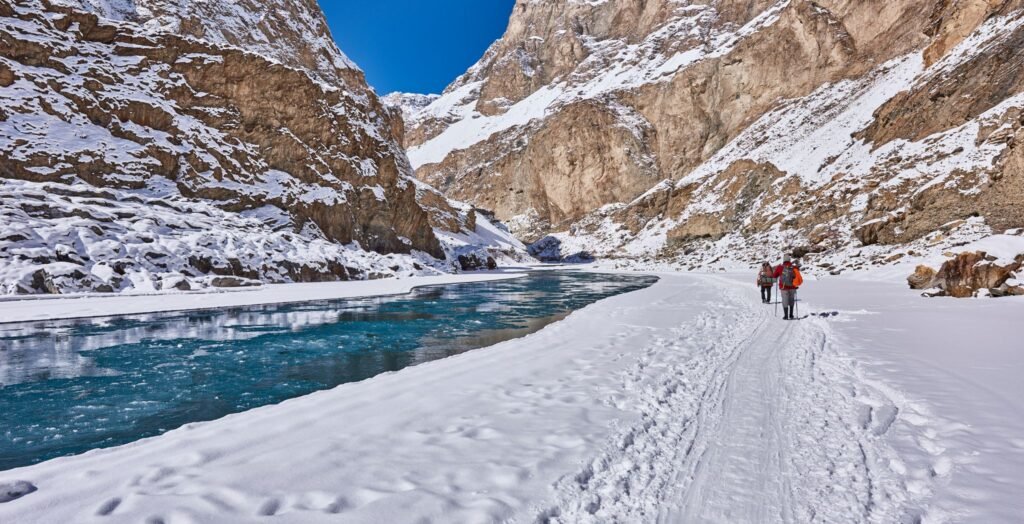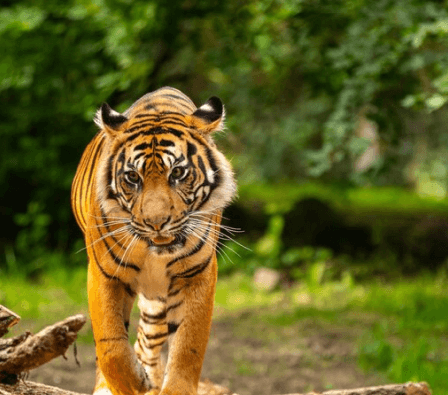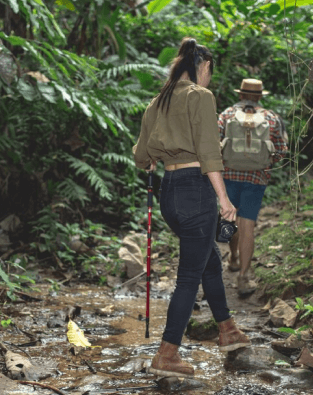What is the Chadar Trek?
The trek’s focal point is the frozen Zanskar River, which turns into a natural ice highway that trekkers can traverse while taking in breathtaking views of the Himalayas.
With snow-covered mountains, icy cliffs, and crisp, cold air as a backdrop, it’s more than just a trek—it’s a beautiful and resilient experience.
The trek is notoriously difficult in the winter, making it a formidable task for those with the courage to undertake it.
Trekkers have a once-in-a-lifetime chance to cross a frozen river in one of the world’s most breathtaking natural settings.
Why is the Chadar Trek So Popular?
Because of its unadulterated, natural relationship with nature, the Chadar Trek has a special place in the hearts of hikers and adventure seekers worldwide.
The thought of crossing a frozen river and entering a vast, deserted area where time seems to have stopped has a certain charm. With its white glaciers, tall mountains, and the chance to cross frozen waterfalls, the trek offers unmatched beauty amidst Ladakh’s untamed landscape.
It is one of the most sought-after trekking experiences in the world because of the extreme difficulty of walking on ice, the unpredictable surface of the frozen river, and the remoteness of the journey.
The Chadar Trek is the ideal chance for experienced hikers looking for the ultimate endurance test to push themselves to the limit and succeed in one of nature’s most hostile environments.
Who Should Attempt the Chadar Trek?
Because the Chadar Trek is so challenging, it is best suited for seasoned hikers or adventure seekers who are mentally and physically prepared for the harsh terrain and bitter cold.
It’s not a beginner’s trek, and it can be risky to attempt without sufficient preparation.
Although there aren’t any steep climbs on the trek, the frozen river can present dangerous conditions due to occasionally thin and unstable ice. In addition, trekkers must endure temperatures that can drop significantly below freezing, which can be exhausting for even the most experienced explorers.
The Chadar Trek is therefore best suited for people who are accustomed to dealing with extremely cold temperatures, possess a strong sense of willpower, and are willing to push themselves in one of the harshest environments on earth.
Chadar Trek Overview
Location
The Zanskar Valley in Ladakh, which is in India’s northernmost region, is where the Chadar Trek is situated. Known as the “Land of High Passes” because of its location in the Indian Himalayas, Ladakh is well-known for its isolated, untamed landscape.
The Zanskar River, which freezes over to create the “Chadar” or blanket of ice during the winter, is the most well-known feature of the Zanskar Valley, which is mainly remote all year round.
The trek offers a unique opportunity to experience the unspoiled beauty and solitude of Ladakh, as the area is sparsely populated and takes you far into this remote part of the world.
The bleak, desolate terrain is breathtaking and frightening, making it a trek destination that will never be forgotten.
The Frozen Zanskar River
The Zanskar River freezes during the bitterly cold winter months because of the region’s extremely low temperatures, which frequently fall to -25°C or below. Altitude, the river’s comparatively sluggish flow, and the bone-chilling temperatures all contribute to the river freezing.
The “Chadar”—the Hindi word for blanket—is the term used to describe the thick, solid blanket of ice that covers the riverbed.
Trekkers use this frozen river as a makeshift route, but the ice can be erratic at times, breaking and cracking, which makes the trip more challenging and exciting.
The river creates a surreal, otherworldly scene that is unlike anything else on Earth, encircled by snow-capped mountains and sheer cliffs.
Duration & Distance
The Chadar Trek usually takes 8 to 9 days to complete, covering about 60 kilometres in total. With stops at different campsites along the way, the trek takes you through isolated, remote terrain. Trekkers traverse the icy surface as they follow the frozen river, occasionally navigating rocky or unstable ice patches.
Given the intense cold and the sporadic perilous ice crossings, the trek can be taxing, so endurance and perseverance are essential.
As hikers traverse the frozen river and take in some of the most stunning natural scenery on earth, the journey provides a satisfying sense of achievement despite the difficult circumstances.
Best Time to Do the Chadar Trek
The Chadar Trek opens when?
The winter months of January and February are the ideal times to go on the Chadar Trek. The most consistent and dependable ice conditions on the Zanskar River are provided during these months, which is critical for the trekkers’ safety.
During this period, the river is completely frozen, making it the perfect surface for hiking. Trekkers risk danger if they attempt the trek too late in the winter (March), when the ice starts to melt, or too early (November to December), when the ice may not be thick enough.
Thus, the best months to enjoy the full challenge and adventure of the Chadar Trek are January and February.
Why Winter?
Temperatures in Ladakh can drop to -25°C or lower during the harsh winter months, particularly at night. The best time to trek on the frozen river is during this time, despite the challenging conditions.
The winter scenery enhances the ethereal beauty of the surroundings, and the cold guarantees that the river stays completely frozen and passable. There is nothing like walking on ice in the middle of a mystical winter wonderland, which is made up of bleak, snow-covered mountains and frozen waterfalls.
In addition to being a challenge, the bitterly cold weather heightens your sense of accomplishment and adventure after finishing the hike.
Weather Conditions
The Chadar Trek experiences harsh weather, with frequent below-freezing temperatures, particularly at night.
At night, the temperature can drop to -25°C or even lower, while during the day it may be between -10°C and -15°C. Trekkers must be well-prepared for the severe weather because the cold can be unrelenting.
Carrying insulated water bottles is crucial because the temperatures can cause water to freeze quickly. Along with the cold, the trek may experience snowstorms, which would make it even more challenging because hikers would have to make their way through places where the ice might be concealed by a new layer of snow.
Because the weather is so unpredictable, hikers need to be ready for anything, from an unexpected snowstorm to a change in the ice conditions.
What to Expect on the Chadar Trek
Trekking on Ice
The experience of trekking on ice is one of the most unique features of the Chadar Trek. With different ice thicknesses and sporadic water patches, the Zanskar River’s surface can be both solid and erratic. Trekkers must walk steadily and slowly, paying attention to the ground beneath their feet.
It is necessary to navigate carefully because the ice can be thick and solid in some areas and thinner or cracked in others. Sometimes, if the ice isn’t thick enough to bear their weight, hikers may have to cross snow-covered rocks.
Walking on ice presents a challenge that is both thrilling and intimidating because it requires close attention to every step, striking a balance between the need for caution and the excitement of adventure.
Beautiful Sceneries
The Chadar Trek offers some absolutely stunning scenery. A narrow corridor of icy terrain is formed by the frozen river winding through the valley and the tall cliffs on either side. In the distance, the snow-capped peaks of the Himalayas provide a breathtaking contrast to the ice-covered landscape.
The trek is a visual masterpiece because of the almost surreal beauty created by frozen waterfalls, icicles dangling from the cliffs, and snow-covered landscapes.
The vast, isolated wilderness heightens the sense of solitude and the unadulterated beauty of nature that is seldom appreciated by others.
Every step on the ice offers a fresh perspective, and the whole experience seems like an ongoing investigation of one of the world’s most pristine natural settings.
Campsites
The Chadar Trek’s simple campsites offer hikers a cosy, shared space to unwind in after a strenuous day of hiking.
Trekkers congregate in the warmth of their tents at these camps, which are usually erected along the banks of rivers, to exchange tales, eat, and consider the day’s travels.
Trekkers frequently huddle together to conserve body heat because it is imperative to stay warm in the frigid temperatures.
As hikers from all over the world come together to share the experience of enduring the cold and trekking through one of the most hostile environments on the planet, the Chadar Trek’s camping experience cultivates a sense of camaraderie.
Cultural Interaction
Trekkers may have the opportunity to engage with the relatively isolated Zanskar Valley residents along the route.
Despite the difficult circumstances they endure in this isolated area, the people of Zanskar are renowned for their friendliness and warmth.
An exceptional chance to discover the customs, culture, and way of life of the locals is offered by trekking through the villages.
For trade, education, and other necessities, the residents frequently move between villages along the same frozen river.
Beyond the journey’s physical difficulty, these exchanges give the trek a cultural component and give hikers a stronger bond with the area.
Preparation for the Chadar Trek
Physical Fitness: Since the Chadar Trek is one of the most physically taxing treks, physical fitness preparation is vital.
Trekkers need to be in top physical shape to endure the bitter cold, rough terrain, and long days of ice trekking. Here is how to get ready:
Cardio Training: Trekkers should concentrate on developing cardiovascular endurance because the journey entails walking great distances, frequently for several hours each day.
Hiking, biking, and running are all great ways to increase stamina. Try to get in at least three to four aerobic workouts per week, progressively increasing the length and intensity.
Strength Training: Because you’ll be walking on uneven, slick surfaces, it’s imperative to develop leg strength.
Step-ups, lunges, and squats are excellent exercises for strengthening the legs. Including core exercises like Russian twists and planks will also improve stability and balance.
Building Endurance: Long walks will help you get used to the demands of the Chadar Trek, particularly in colder climates.
Use a weighted backpack or walk on uneven terrain to try to replicate trekking conditions.
Mental Preparation: Just as crucial to this journey as physical fitness is the mental fortitude needed. The harsh environment and difficult terrain necessitate a resilient, upbeat attitude. Mental endurance can be improved by visualisation exercises, breathing exercises, or meditation.
Trekking Equipment
Adequate equipment is necessary to endure the challenging Chadar Trek conditions. Here is a comprehensive list of the items you will require:
Thermal Layers: To ward off the icy cold, wear thermal innerwear. They wick moisture away from your body and offer insulation, so they should be worn as a base layer.
Waterproof boots: Essential for walking on snowy and icy terrain. Your feet will stay warm and dry if you wear boots with adequate insulation and waterproofing.
Gaiters: During a hike, gaiters are protective coverings for your legs that keep water and snow out of your boots.
Walking Poles: When it comes to staying balanced on icy terrain, trekking poles are immensely helpful. They offer stability throughout the walk and lessen the chance of slipping.
Sleeping Bags and Insulated Liners: A good sleeping bag made for extremely cold temperatures is essential. For extra warmth at night, an insulated liner is also strongly advised.
Headlamp: A headlamp is necessary for early starts or trekking after sunset because winter daylight hours are short.
Sunscreen: At high elevations, the sun can still be harsh even in the midst of freezing temperatures. Applying sunscreen is essential for shielding your skin from UV radiation.
Water Purification Tablets: Having water purification tablets on hand will guarantee that you have access to safe drinking water even in the event that there are no dependable water sources.
Gloves: Wearing several layers of gloves will help keep your hands warm. Waterproof gloves will keep out moisture, while fleece or wool gloves will keep you warm.
Things to Bring
A detailed packing list for the Chadar Trek can be found here:
– Poles for trekking (for balance on ice)
– Waterproof bags to keep equipment and clothing dry
– Warm Clothes (gloves, woollen hats, and thermal layers)
– First Aid Kit (for small wounds)
– Snacks to maintain energy levels, such as energy bars and dried fruits
– Tablets for Water Purification
– Personal belongings (a camera to record memories, toiletries)
– Footwear (extra socks, waterproof trekking boots)
– Sleeping equipment (two sleeping bags and warm liners)
Considerations for Trekking Permits
Obtaining the required permits is crucial before starting the Chadar Trek. To enter Zanskar Valley and some of the surrounding areas, one must have an Inner Line Permit (ILP).
Trekkers are guaranteed permission to traverse restricted areas, which are frequently nearer delicate borders, with this permit.
The ILP is available in Leh, and it’s crucial to confirm that all necessary permits are in order by contacting the local government or your trekking agency.
Depending on the regions you intend to visit, you may require additional trekking permits or clearances in addition to the ILP.
It’s best to check the permit requirements well in advance of your trip because some locations close to military zones or protected wildlife areas may need special permissions.
Respect Local Culture:
Because the Zanskar Valley is home to a large Buddhist population, it is crucial that hikers respect the customs, traditions, and culture of the area.
The Zanskar people have a strong bond with their religious rituals and way of life, and they live a modest and solitary existence. Remember the following cultural norms:
Show Respect by Saying “Juley,” which translates to “hello” in Ladakhi, when you meet a local.
Respect Monasteries:
Make sure to act with courtesy when you visit a Buddhist monastery or prayer flags. Avoid making loud noises and always circle holy places in a clockwise direction.
Local Clothes:
Because the area has traditional clothing values, make sure you dress modestly when trekking, especially when interacting with locals.
You will have a better experience and have more pleasant interactions with Zanskar residents if you take the time to learn about and appreciate the local way of life.
Eco-Friendly Trekking:
Trekkers traverse an exceptionally pristine and delicate environment on the Chadar Trek. Reducing your impact and using ethical trekking techniques are essential if you want to help protect this stunning area for coming generations.
Here are some essential guidelines for environmentally friendly hiking:
Leave No Trace:
Bring biodegradable items along with all of your waste. Trekkers must remove all trash because the area lacks a waste management system.
Use Eco-Friendly Products:
Steer clear of single-use plastic as much as you can and opt for eco-friendly toiletries like biodegradable soap.
Respect Wildlife:
Avoid upsetting wildlife or harming trailside vegetation.
Conserve Water:
Pay attention to how much water you use. Make sure to purify any water you gather from the river and use water purification tablets to prevent wasting bottled water.
By implementing eco-friendly practices, the area’s natural beauty will be preserved for future generations.
Frequently Asked Questions (FAQs) About the Chadar Trek
1. Can novices complete the Chadar Trek?
Despite being an amazing adventure, the Chadar Trek is not advised for novices. Extreme cold, walking on ice that is unstable, and long trekking hours are some of the difficult conditions that come with the trek.
It calls for mental toughness, physical stamina, and prior experience trekking in challenging environments.
It’s advisable for novices to gain experience on other treks before taking on the Chadar Trek.
2. To what extent is the Chadar Trek challenging?
The Chadar Trek is regarded as a difficult walk. The trek’s primary challenges are the intense cold, the erratic ice conditions, and the lengthy walking days, even though there aren’t any steep climbs.
Trekkers must constantly adjust to walking on ice because temperatures can drop as low as -25°C.
To successfully finish the trek, one needs to be mentally tough, physically fit, and have endurance.
3. Does the Chadar Trek require a guide?
Yes, going on a trek with a knowledgeable guide is highly advised. With fluctuating ice thickness and the potential for abrupt weather changes, the Chadar Trek can present a number of unpredictable conditions.
For your safety and to make sure you’re on the right path, you need a guide who knows the route and conditions.
Trekking agencies also help make sure that permits and other required arrangements are in place and offer logistical support.
4. How long does the Chadar Trek take?
The Chadar Trek usually lasts eight to nine days. Campsites are positioned along the way as the trek traverses the frozen Zanskar River for about 60 kilometres.
There is plenty of time to take in the scenery and get used to the cold because the pace is leisurely.
Depending on the terrain and conditions, trekking entails walking for 6–8 hours each day, covering about 8–12 kilometres.
5. Is it possible to complete the trek without a reputable trekking agency?
Although it is technically feasible, it is strongly discouraged to attempt the Chadar Trek without a trekking agency.
The difficulty of the trek, coupled with the harsh weather and isolation of the region, makes it risky for lone hikers without the assistance of a knowledgeable organisation.
To make the experience safer and more pleasurable, a trekking agency will supply necessary services like guides, porters, camping equipment, permits, and safety precautions.
Additionally, independent hikers run the risk of encountering logistical difficulties like obtaining permits, transportation, and local expertise.










